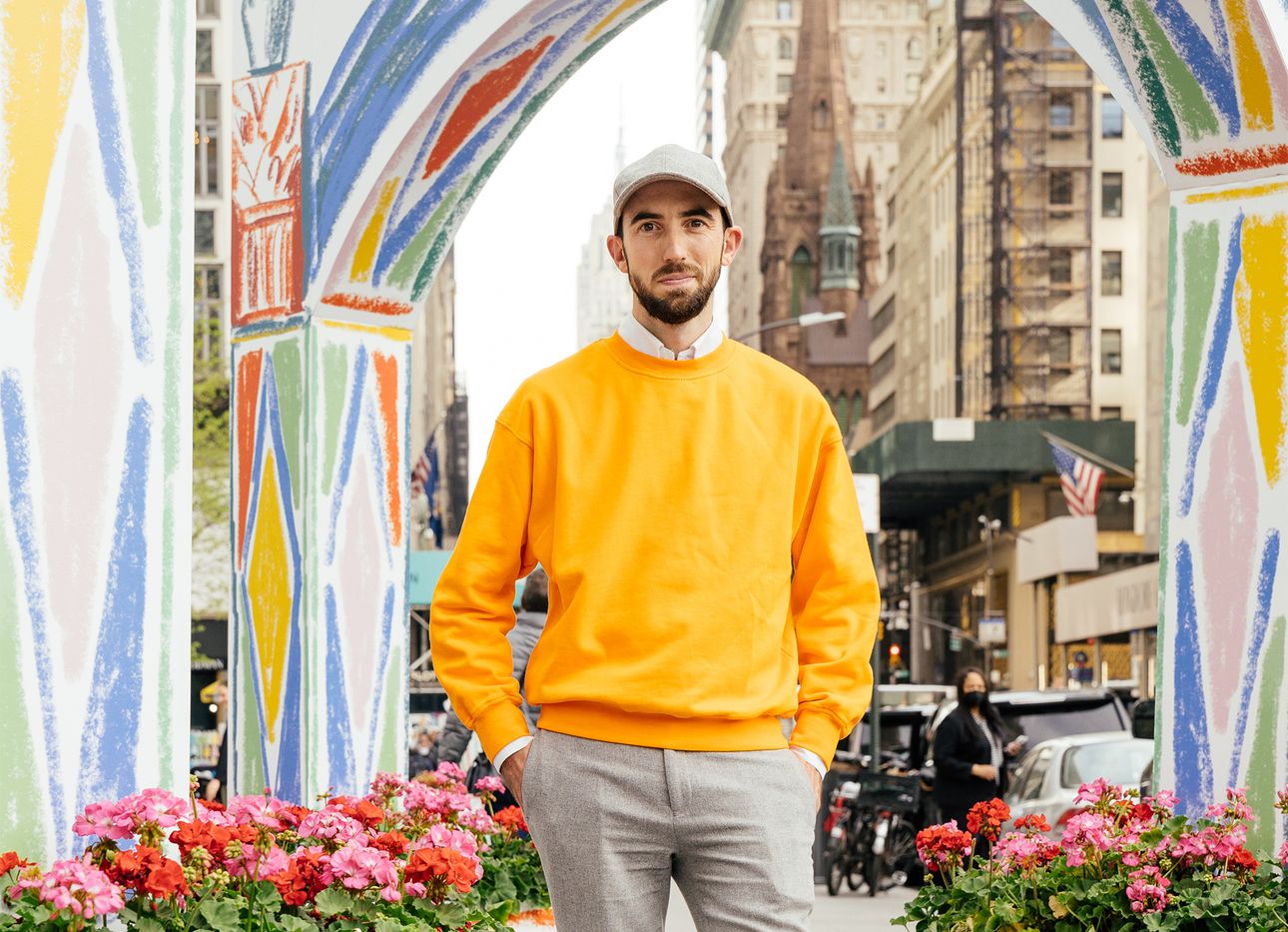
Alexandre Benjamin Navet Presents Flowers, Real and Imagined, on New York’s Fifth Avenue
May’s colors, textures, and sense of renewal seem to be essential ingredients in Paris-based artist Alexandre Benjamin Navet’s exuberant work. A self-described “spring and summer boy,” his expressive drawings—often made in watercolor or oil pastel—of vases, chairs, and other elaborate home furnishings have served as the basis for vibrant installations, including a sprawling creation inside Paris’s Musée des Arts Décoratifs, the yachting décor of a pop-up at the city’s Hôtel de Crillon, and hand-painted frescoes at the Hotel des Arts in Toulon.
Among his latest efforts, unveiled at the top of the month, is “Fifth Avenue Blooms Imagined by Van Cleef & Arpels,” (through May 31), a series of immersive installations Navet created, in collaboration with the historic French jewelry maison, that grace a dozen blocks of Manhattan’s famed thoroughfare. In celebration of the season and the company’s affinity for nature’s flora and textures, Navet transformed the streets into a whimsical, dreamlike environment resplendent with larger-than-life vases, playful architectural columns and arches, and an inviting veranda-inspired bench—all illuminated by his signature strokes of bold, unbridled color. Planters, filled with live flowers, punctuate the structures, honoring the many blooms that have inspired Van Cleef & Arpels’s designs for more than a century. (To further enhance the experience, there’s also an augmented-reality component that can be launched by scanning a QR code, allowing visitors to send a virtual butterfly to a friend via text message.)
Van Cleef & Arpels’s connection to New York, and to Fifth Avenue in particular, runs deep. In 1939, the maison’s founders, the Arpels family, traveled from Paris to Manhattan to attend the World’s Fair, where they showcased Parisian style jewelry: innovative, skillfully crafted pieces, designed especially for the occasion. The resulting enthusiastic response prompted the family to open the company’s first stateside boutique, in 1942, at 744 Fifth Avenue, which has served as a symbol of Van Cleef & Arpels’s enduring legacy in the United States ever since.
Navet’s installation marks the latest output of Navet and Van Cleef & Arpels’s ongoing creative partnership. After winning the grand prize at the interior design festival Design Parade Toulon at Villa Noailles in Hyères, France, in 2017, Navet was approached by the maison to develop artworks for several of its boutiques around the world—including the façade of its Fifth Avenue location—translating his cheerful sketches and geometric prints into window displays, wallpaper, and textiles. The launch of this month’s installation, in the midst of the moment’s cautious optimism, feels particularly special.
We recently spoke with Navet by phone as he visited the Metropolitan Museum of Art (he was in town to oversee the Fifth Avenue project’s installation), to learn more about how he sees Van Cleef & Arpels, and New York City, through the lens of his work. Asked what part of the institution he was in, he responded, “A gallery full of vases!” Where else?
When conceiving your installations, you often create something site-specific. How did Fifth Avenue inspire the drawings you made for its streets?
New York always fills me with energy—particularly Fifth Avenue. It’s a symbol that evokes the city’s greatness and effervescence. For “Fifth Avenue Blooms,” the nature and architecture around the site were the greatest sources of inspiration. I love ornamental details in the built environment, and the richness of architecture is exceptional in New York. You can see ornate details on the vases in the installation, which came from buildings all around. I never thought it would be possible to create such a project in Manhattan—to have this kind of carte blanche to celebrate spring is the most exciting opportunity. I like to draw, but this is the first time I’m drawing on such a scale as this: on a map, on a city.
You’ve been collaborating with Van Cleef & Arpels for several years now. What made this project stand apart?
This is the first time we made a dialogue between live flowers and my drawings, which resulted in a really nice exchange. I worked with a talented floral designer, who connected the physical flowers to my color palette. So if an area of the installation had a lot of blue, there would be a complementary color within it, through the flowers. There was so much attention to detail.
Flowers are not only integral to the installation, but to Van Cleef & Arpels’s history and identity as well. How have blossoms shaped your work with the company?
I feel very inspired by blooming flowers and their ephemeral beauty. But before I first met with the maison, I never drew flowers—so we are connected by something special, and by something that is at the center of the Van Cleef & Arpels brand. And for the Fifth Avenue project, we created new, imaginary flowers. That’s something else I share with the maison: making big surprises, and making people feel joyful. My work and my everyday life is about that. This is why I use vivid colors. They’re strong, and they talk to you in a powerful way.
It’s true. It’s almost as if the streets of Fifth Avenue are a portal into another world.
I wanted to create the illusion that strange colors appeared on the building façades at night, as if by magic. I like to play with perspective and scale, and color is always all around. When people experience this installation, they’ll feel like they’re in a giant open sketchbook.
Have you ever been surprised by how people respond to your installations?
Always. I like seeing the faces of people walking through them. I spent some time on Fifth Avenue this week, looking at the structures and how people play with them. I’ve long wanted to make theatrical décor, and this project gave me the opportunity to experiment with exactly that. It creates a lot of emotion within me when I see these scenes happening in reality. They’re full of life.